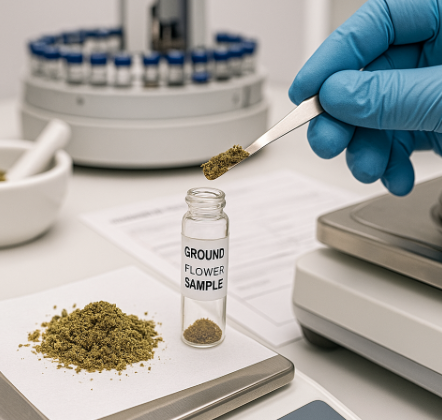Cannabis Testing
Introduction to Cannabis Testing
What Is Cannabis Testing?
Cannabis testing is the scientific analysis of cannabis flower, concentrates, and infused products to determine their composition and safety. Labs evaluate cannabinoid content, terpene profiles, and contaminants to ensure consumers receive accurate, reliable products.
These tests are essential for quality control, regulatory compliance, and consumer education—helping growers and users alike understand potency, effects, and safety.

Why Cannabis Testing Matters
- Safety: Detects contaminants like mold, pesticides, solvents, and heavy metals.
- Accuracy: Confirms THC, CBD, and other cannabinoid percentages for proper labeling.
- Transparency: Builds consumer trust and meets legal compliance standards.
- Quality Insights: Helps growers improve genetics, curing, and nutrient balance.
THC, CBD & Cannabinoid Testing
Labs measure the concentration of cannabinoids such as THC, CBD, CBG, and CBN using methods like High-Performance Liquid Chromatography (HPLC). These values determine the plant’s potency and type of effect:
- THC (?9-Tetrahydrocannabinol): The main psychoactive compound that provides euphoria and relaxation.
- CBD (Cannabidiol): Non-psychoactive and known for calming and therapeutic benefits.
- CBG: A “mother cannabinoid” that may enhance focus and neuroprotection.
- CBN: A mildly sedative compound formed as THC oxidizes, associated with sleep aid effects.
Terpene Profiling
Terpenes are aromatic compounds that give cannabis its scent and contribute to flavor and effects. Testing identifies the dominant terpenes, revealing whether a strain is energizing, calming, fruity, or earthy.
- Myrcene: Sedative, musky, and herbal — common in relaxing indicas.
- Limonene: Citrusy and uplifting — linked to mood elevation and stress relief.
- Pinene: Pine-scented — promotes alertness and memory retention.
- Caryophyllene: Spicy and peppery — interacts with CB2 receptors for anti-inflammatory benefits.
- Linalool: Floral and calming — associated with relaxation and anti-anxiety effects.
Contaminant & Safety Testing
Safety testing ensures that cannabis is free from harmful elements before sale or consumption. Common analyses include:
- Pesticides & Fungicides: Detects chemical residues from cultivation.
- Heavy Metals: Identifies lead, mercury, arsenic, and cadmium contamination.
- Microbial: Checks for mold, yeast, and bacterial pathogens.
- Residual Solvents: Ensures solvent purging in extracts and concentrates.
How to Read a Cannabis Lab Report
Test results are typically presented as a Certificate of Analysis (COA). Understanding it helps you interpret quality and potency:
- Total THC & CBD: Represents combined active and inactive forms (THC + THCa, CBD + CBDa).
- Terpene Percentage: Shows the concentration of major terpenes, usually 1–5% total.
- Moisture Content: Ideal range is 10–12% for smooth burns and proper curing.
- Pass/Fail Results: Indicates compliance with state safety limits.
Home Growers vs. Commercial Compliance Testing
Not all testing is created equal. Here’s how informal, at-home testing compares to state-recognized compliance testing.
Home / “For Fun” Testing
Great for learning about your harvest, comparing phenos, and dialing in your grow. Results are educational—not regulatory.
- Purpose: Curiosity, process tuning, journaling
- Typical tools: DIY kits (often TLC), handheld analyzers, hygrometers
- What you learn: Rough potency (THC/CBD), aroma/terpene trends, drying/curing insights
- Limitations: Not validated, wide error bars, no certified contaminant screening
- Recognition: Not accepted by regulators or retailers
Commercial / Compliance Testing
Required for licensed producers. Conducted by state-accredited labs with chain-of-custody and validated methods.
- Purpose: Legal labeling, safety, market eligibility
- Methods: HPLC (cannabinoids), GC-MS/GC-FID (terpenes), full contaminant panels
- Scope: Potency, terpenes, pesticides, heavy metals, microbes, residual solvents, moisture/water activity
- Documentation: Certificate of Analysis (COA) with batch ID and pass/fail vs. state limits
- Consequences: Failures can block sale, require remediation, or trigger recalls
Key Differences at a Glance
| Feature | Home / Fun | Commercial / Compliance |
|---|---|---|
| Goal | Learning & trend tracking | Legal certification & safety |
| Accuracy | Approximate / educational | High precision, validated |
| Contaminants | Limited or none | Full panel per state rules |
| Recognition | Not accepted by regulators | Accepted for market sale |
| Cost / Speed | Low cost, quick results | Higher cost, lab turnaround |
Disclaimer: Regulations vary by state. Always verify current testing requirements with your local cannabis authority.